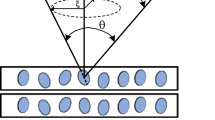Abstract
The paper describes the results of an experimental study of the 35Cl and 14N nuclear quadrupole resonance in composite and porous materials, the influence of the environment and the crystallite size of powder on the nuclear quadrupole resonance line widths, as well as on the spin–spin and spin–lattice relaxation times. It is established that the spin–lattice relaxation time has a unimodal distribution, and the spin–spin relaxation time—bimodal distributions for all the investigated samples. The idealized distribution function of the relaxation times is obtained on the assumption that the concentration of inhomogeneities and relaxativity decreases with an increasing distance from the surface into the interior of the crystallite exponentially. It is shown that the model with the spin diffusion explains the shortening of the decay signal with decreasing grain size, but this is not confirmed by the experimental distribution of relaxation times obtained by means of the inverse Laplace transformation.









Similar content being viewed by others
References
S.R. Rabbani, D.T. Edmonds, Phys. Rev. 50, 6184–6188 (1994)
S.R. Rabbani, C. Mendonca, J.B. Mamani, H. Cervantes, R. Braz. J. Phys. 36(1A), 28–33 (2006)
K.R. Brownstein, C.E. Tarr, Phys. Rev. A 19, 2446 (1979)
P.N. Dolinenkov, N.Ya. Sinyavsky, Vestnic of the Immanuel Kant Baltic Federal University, Kaliningrad 10, 119–126 (2012) (in Russian)
N.Ya. Sinyavsky, in Collection of scientific papers SWorld. Proceedings of the International Scientific-Practical Conference “Scientific Research and Its Practical Application”. The Current Status and Development ‘2012’, vol. 32(3) (Kuprienko, Odessa, 2012), pp. 52–55 (in Russian)
N. Sinyavsky, G.V. Mozzhukhin, P. Dolinenkov, in Magnetic Resonance Detection of Explosives and Illicit Materials, NATO Science for Peace and Security Series B: Physics and Biophysics (Springer, Dordrecht, 2014), pp. 69–76
M. Iari-Gabriel, Regularized Inverse Laplace Transform, http://www.mathworks.com/matlabcentral/fileexchange/6523-rilt/content/rilt.m
S.W. Provencher, Comput. Phys. Commun. 27, 229 (1982); http://s-provencher.com/pages/contin.shtml
G.C. Borgia, R.J. Brown, P. Fantazzini, J. Magn. Reson. 132(1), 65–77 (1998)
G.C. Borgia, R.J. Brown, P. Fantazzini, J. Magn. Reson. 147(2), 273–285 (2000)
K.P. Whittall, A.L. MacKay, J. Magn. Reson. 84, 134–152 (1989)
M.L. Buess, S.M. Caulder, Appl. Magn. Reson. 25, 383–393 (2004)
Acknowledgments
The study was supported in part by the Russian Foundation for Basic Research (project no. 14-03-00038a).
Author information
Authors and Affiliations
Corresponding author
Rights and permissions
About this article
Cite this article
Sinyavsky, N., Dolinenkov, P. & Kupriyanova, G. The T 1 and T 2 Relaxation Times Distribution for the 35Cl and 14N NQR in Micro-composites and in Porous Materials. Appl Magn Reson 45, 471–482 (2014). https://doi.org/10.1007/s00723-014-0533-7
Received:
Revised:
Published:
Issue Date:
DOI: https://doi.org/10.1007/s00723-014-0533-7




